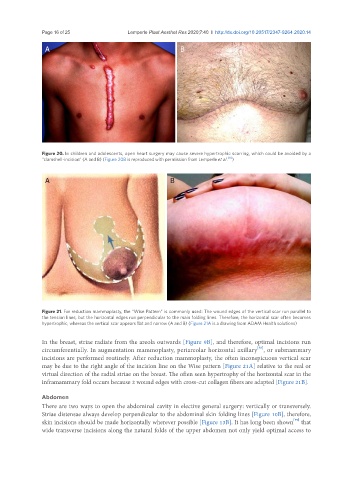Page 447 - Read Online
P. 447
Page 16 of 25 Lemperle Plast Aesthet Res 2020;7:40 I http://dx.doi.org/10.20517/2347-9264.2020.14
A B
Figure 20. In children and adolescents, open heart surgery may cause severe hypertrophic scarring, which could be avoided by a
[11]
“clamshell-incision” (A and B) (Figure 20B is reproduced with permission from Lemperle et al. )
A B
Figure 21. For reduction mammaplasty, the “Wise Pattern” is commonly used: The wound edges of the vertical scar run parallel to
the tension lines, but the horizontal edges run perpendicular to the main folding lines. Therefore, the horizontal scar often becomes
hypertrophic, whereas the vertical scar appears flat and narrow (A and B) (Figure 21A is a drawing from ADAM Health solutions)
In the breast, striae radiate from the areola outwards [Figure 9B], and therefore, optimal incisions run
circumferentially. In augmentation mammoplasty, periareolar horizontal axillary , or submammary
[38]
incisions are performed routinely. After reduction mammoplasty, the often inconspicuous vertical scar
may be due to the right angle of the incision line on the Wise pattern [Figure 21A] relative to the real or
virtual direction of the radial striae on the breast. The often seen hypertrophy of the horizontal scar in the
inframammary fold occurs because 2 wound edges with cross-cut collagen fibers are adapted [Figure 21B].
Abdomen
There are two ways to open the abdominal cavity in elective general surgery: vertically or transversely.
Striae distensae always develop perpendicular to the abdominal skin folding lines [Figure 10B], therefore,
[39]
skin incisions should be made horizontally wherever possible [Figure 13B]. It has long been shown that
wide transverse incisions along the natural folds of the upper abdomen not only yield optimal access to

